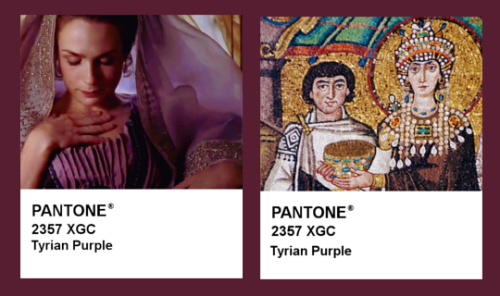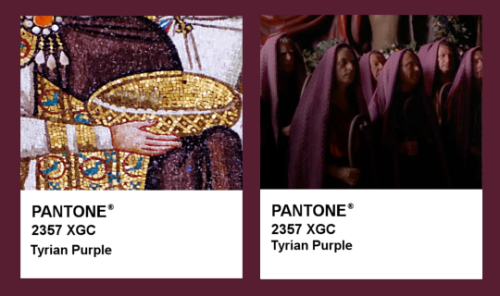vinceaddams: codexgrolier:HISTORY IN COLOR Tyrian Purple RGB: (123, 35, 109)Closest Pantone matc
vinceaddams: codexgrolier: HISTORY IN COLOR Tyrian Purple RGB: (123, 35, 109)Closest Pantone match: 2357 XGC Production of Tyrian Purple in the Eastern Mediterranean dates back to the Bronze Age. Workshops in the Phoenician cities of Tyre and Sidon harvested and crushed hundreds of thousands of Murex snail shells in order to extract the mollusk’s hypobranchial glands. The liquid extracted from the putrified glands produced a brilliant and durable dye, the hues of which only seemed to get brighter the more they were exposed to sunlight and wear. For example, the mortuary shroud of Charlemagne, who was buried in 814 CE, remains a vibrant purple even today. Due to its resource- and labor intensive production, Tyrian purple was prohibitively expensive. By the time of the Roman emperor Diocletian, half a kilogram of dye cost 150,000 denarii, or over a kilogram of gold. As such, wearing purple was a privilege restricted to the upper and ruling classes. In Rome, this privilege had morphed into a sumptuary law that restricted the use of purple to senior members of the ruling class. By the fourth century BCE, only the emperor was allowed to wear purple. Due to this, Tyrian purple is also called imperial or royal purple. The production of dye nearly caused the Murex snail’s extinction in the Eastern Mediterranean, and its high cost illustrated the sharp divide between those who could spend lavish amounts of money dying a strip of cloth and those who couldn’t even dream of such a luxury. This all changed in 1856, when 18-year old William Henry Perkin accidentally discovered the first aniline dye, mauveine, a close match for the costly Tyrian purple. That last paragraph is very misleading. They had other purple dyes long before 1856. The invention of mauveine and other aniline dyes made bright colours cheaper and more widely available, and the colours were more intense than naturally dyed ones, but it doesn’t mean there was only one source of purple dye up until then. Logwood and alkanet both make a variety of nice purples, and you can overdye indigo with red to get purple shades. I’ve seen plenty of images of clothing from earlier periods in lovely bright purples, like this stunning c.1720′s-30′s velvet coat, this Regency spencer, this 1780′s-90′s waistcoat fragment, or this c. 1790 court suit! In fact, “Elements of the Art of Dyeing” from 1791 talks about Tyrian purple as something that’s ancient history. “Although the ancients might have employed some substances, of which we have no account, we easily perceive that our acquisitions, more especially since the discovery of America, give us a decided superiority in many colours. With respect to the regret which has been often felt for the loss of the art of dyeing the celebrated purple, it may be questioned whether it is well founded, and whether we are not able to produce a purple equally beautiful?” “Our indifference as to procuring the purple, and our negligence of the experiments of some modern philosophers, respecting it, arise, I think, from our being already in possession of more beautiful, as well as much less expensive colours; and I am not singular in this opinion.“ -- source link
Tumblr Blog : codexgrolier.tumblr.com
#vinceaddams


